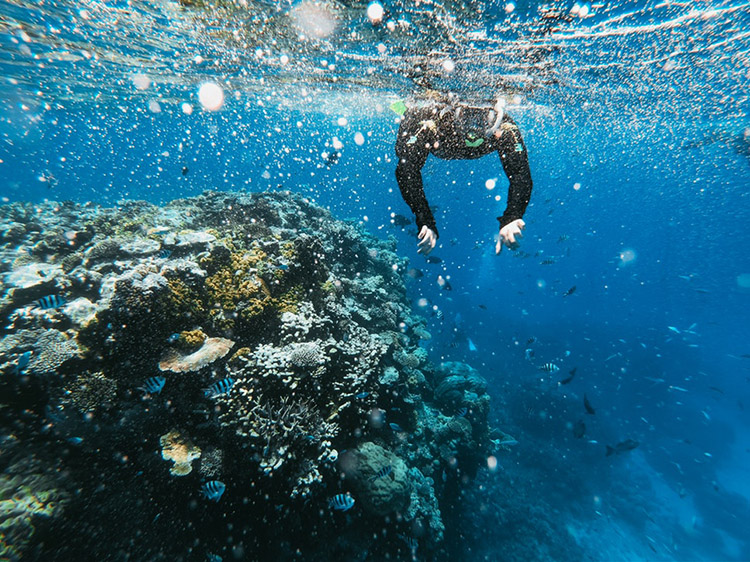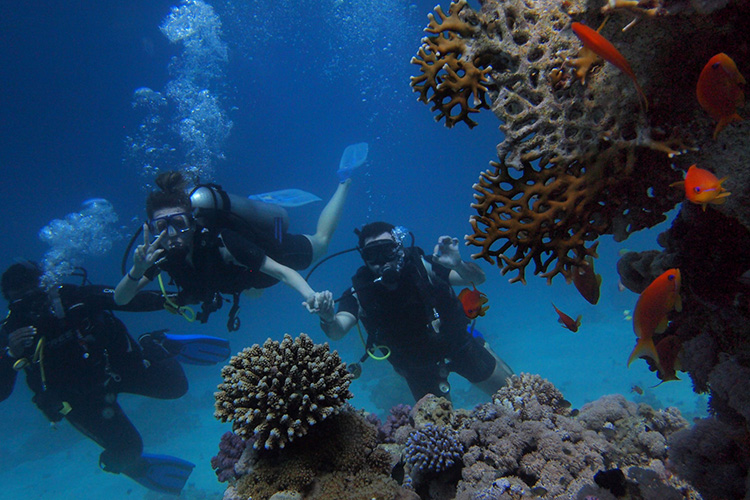
People from all over the world view Australia as a dream holiday destination with a unique mixture of different environments.
From big smoke cities, barren countryside, sandy deserts, tropical rainforest, and giant statues of animals and fruits (you have see the Big Banana!) scattered across the country.
As well as all the great stuff to see, Australia really likes to show off when it comes to beaches and coastlines, and the wonderous underwater ecosystems and beautiful creatures that inhabit them. Fortunately, most of these ecosystems are shallow enough for people to snorkel around in.
While you’d naturally want to see all of the Great Southern Land (emphasis on “land” here), that doesn’t mean you can’t see what’s underwater too. Mars Campers can recommend some great campsites around the country to stay at while exploring our oceans.

The West Australian town of Busselton is home to the world’s longest wooden jetty, aptly named Busselton Jetty.
Spreading 1.8 km over the water into Geographe Bay, the jetty is impressive not only because of its crazy size but also because it’s one of the top scuba diving and snorkelling sites in WA.
Some ideal snorkelling sites are alongside the jetty where marine life thrive. Take advantage of having more than 300 beautiful creatures hanging out here to get the most out of your time here.
But if you’re not into snorkelling, then head over to the end of the jetty where the underwater observatory is located.
Here you’ll be able to descend 8 metres down a spiral staircase to the ocean floor to gaze at the colourful tropical and sub-tropical marine life and corals.
Besides the jetty, the surrounding bay has 20 km of pristine sandy beaches that are great places to go snorkelling too. At this rate, they should’ve called the jetty Snorkel Jetty!
Nearby camping sites:
The word Ningaloo is actually an Aboriginal word that means “promontory”, which is exactly what it is. On top of that, the reef is a UNESCO World Heritage site!
It is also Australia’s largest fringing reef that is 300 km in length and covers 600,000 hectares! With all that space available, it’s no wonder that 250 coral species and more than 500 fish species live there!
These factors make the reef a great place to go snorkelling, and snorkellers can easily walk to the reef from the beach. The list of sea life creatures goes on with sightings of whale sharks, humpback whales, dolphins, manta rays, turtles and orcas.
If you want to see some sites on land instead, this area is the Cape Range National Park. Here you can see some red kangaroos, rock wallabies, wallaroos, echidnas, goannas, and over 100 bird species. With both the reef and the park around, you’re really spoiled for choice.
Nearby camping sites:
Sometimes called “The Gem of South East Queensland”, Moreton Island is one of the largest sand islands in Australia. In fact, there are no roads because of all of its sand, so you’ll need a 4WD to get around.
It’s easy for Brisbanites to get to Moreton Island, as it’s only 25 km away from the shores of Brisvegas. There’s some amazing scenery here including beaches, clear lakes, rocky outcrops and forests.
If you’re camping here, then you’re in for a treat, as the sky looks the way it should always look, full of stars, making it a perfect place for sleeping under them.
Besides what’s on land, Moreton Island is a great place for snorkelling. The best snorkelling spot are located around a bunch of shipwrecks.
Although it wouldn’t have been any fun to be on those ships when things went south, snorkelling around these clear waters is an amazing experience.
The area is surrounded by heaps of the local dolphins, turtles, stingrays and vividly colourful corals.
Nearby camping sites:
As if Bryon Bay doesn’t get enough action from beachgoers already, Julian Rocks is a volcanic rock island only 2.5 km away from town.
The place is the remains of a volcanic eruption that happened over 20 million years ago, but its unspoiled waters are as gorgeous as ever.
Underneath are shallow, crystal-clear waters that are ideal to snorkel in. Over 1,000 marine species call this home, including grey nurse sharks, leopard sharks, wobbegongs, turtles, nudibranchs, leaf scorpionfish, cuttlefish, pineapple fish, white anemone fish, and many other jaw-dropping creatures.
Nearby camping sites:

Port Douglas is one of those Queensland towns that give the Sunshine State its great reputation as a holiday retreat.
Only 15 km away from the Port Douglas coast are the Low Isles, meaning you don’t have to hike to the middle of nowhere to see the area’s natural beauty and enjoy the best of Port Douglas itself.
The Low Isles include a four-acre coral cay, surrounded by 55 acres of reef very close to the island, helping to make snorkelling easy and fun.
The Low Isles are popular for snorkellers to see plenty of underwater beauty, including sea turtles, clownfish, colourful corals, large fishes, and various types of other marine life.
Nearby camping sites:
The Ninepin Point Marine Reserve is situated in Gordon, a town only an hour’s drive away from Hobart. This rocky reef covers 59 hectares and extends 500m south into the Dentrecasteaux Channel.
This Tasmanian reef’s water temperatures range from 8°C (don’t forget your wetsuit) to 20°C, giving the water a tea colour that reduces the levels of light it receives.
This lack of light makes it a perfect breeding ground for species that are normally only seen in very deep levels of water.
The area has over 80 species of red algae, 100 species of seaweed, sea tulips, sponges, lacework bryozoans and kelp forests. Living in this fascinating place are creatures like sea dragons, fairy penguins, and migrating whales.
Nearby camping sites:

It’s easy for Sydneysiders to get to Jervis Bay, as it’s only 180km away from home. Anyone who comes here can easily set up their camper trailer or tent in the camping areas close to the beach in Booderee National Park.
Jervis Bay is a beautiful, so it’s highly recommended that you do some cycling or go on some bushwalks around the area where you can spot some local wildlife such as wallabies, echidnas, and lorikeets, to get the most out of your stay.
But let’s get to the snorkelling. These unspoilt waters are home to a wide range of tropical fish, including penguins, seals, whales, bottlenose dolphins, stingrays, octopuses, weedy sea dragon, eastern blue devilfish, sea urchins, and sea hares.
Nearby camping sites within the Booderee National Park:
You may be wondering why we haven’t mentioned the Great Barrier Reef yet, but we’ve been saving the best for last!
Countless tourism ads for both Queensland and Australia, in general, have prominently featured the Great Barrier Reef, and for good reason.
The “great” in Great Barrier Reef is because it’s both tip top and huge! Like, ridiculously huge! Because it’s so huge, we’ll focus on the Whitsundays.
The Whitsundays contains 74 islands, we’ll narrow it down to just the Knuckle Reef Lagoon, which is 100km off the coast from Airlie Beach.
The reef’s ideal water temperature is great for coral growth and it has a tidal range that helps to transport food and nutrients to feed the reef.
This complex needs to work in order to feed the 1400 different species of coral and 200 fish species that live here. Its inhabitants include giant clams, slow-moving sea turtles, spotted fish, and clownfish.
Nearby camping sites:
If you’re ever keen to see what Australia has living under its waters, call Mars Campers on 1300 667 868 for our wide range of camper trailers to travel to these exotic locations.